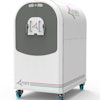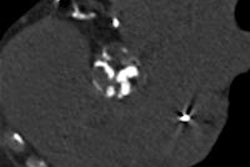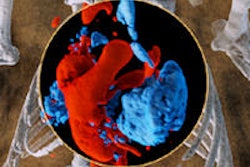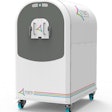Two new editorials in the Journal of the American Medical Association suggest new ways to navigate the gulf between advocates and skeptics of CT lung cancer screening by placing limitations -- for now, at least -- on the screening of Medicare-aged smokers.
The two opinion pieces advocate at least a partial retreat from Medicare payments for screening on demand for high-risk individuals age 65 or older. The proposals are getting wary reviews from radiologists involved in CT lung cancer screening.
The opinions come in an atmosphere of growing pressure by Congress and screening advocates -- more than 70 organizations so far -- to green light screening in Medicare-aged individuals at high risk for lung cancer. CT proponents are convinced that the evidence in favor of screening seniors is already sufficient, inasmuch as individuals older than 65 accounted for one-quarter of the screened population in the National Lung Screening Trial (NLST).
This opinion was bolstered by a new analysis of NLST results that appeared earlier this month. The study concluded that the benefits of screening are largely the same for Medicare-aged individuals and younger people.
Shared decision-making
In the first editorial, Robert Volk, PhD, and colleagues from MD Anderson Cancer Center recommend restricting reimbursement to situations in which CT lung cancer screening involves a formal shared decision-making process between physicians and individuals (JAMA, September 24, 2014, Vol. 312:12, pp. 1193-1194).
Such a process could overcome some of the objections that were raised in an April 30 meeting of the Medicare Evidence Development and Coverage Advisory Committee (MEDCAC).
The editorial reviewed key questions posed by the MEDCAC panel, including a question about members' confidence that the benefits of CT screening outweighed its harms, and members' confidence that those harms would be minimized.
Volk and colleagues noted that the U.S. Preventive Services Task Force (USPSTF), in its December 2013 recommendation of lung cancer screening, endorsed the principles of shared decision-making between patient and provider to ensure that patients choosing CT screening are fully informed of the benefits and potential risks. USPSTF recommended that it be implemented for all individuals as a condition of undergoing screening.
But how would shared decision-making play out in practice? Could it be too time-consuming to be practical?
"One strategy that has been proven and that I think would work well in the screening context is a patient decision aid -- a tool that summarizes the evidence about the choices that a patient faces, presents the evidence in a complete and balanced way, and begins to help the patient think about what's important to them or their values in making a decision," Volk told AuntMinnie.com.
The decision aid can be thought of as an adjunct to the clinical encounter. In the clinical encounter, the clinician would sit down with the patient and explore his or her understanding of the options, correcting misconceptions and answering questions to help the patient arrive at an optimal strategy, Volk said. For a particular patient, that decision might be in favor of not screening.
However, having a patient sit down with a primary care doctor for 30 minutes just to talk about lung cancer screening would not be feasible.
"With the use of these patient decision aids, much of the education of the patient can be done very effectively through the patient completing the tool," he said.
Shared decision-making could address many of MEDCAC's concerns by "minimizing implementation variances and improving patient-physician communications about the risks and benefits of low-dose CT screening," Volk and colleagues wrote in their piece.
In an email to AuntMinnie.com, Dr. Ella Kazerooni, chair of the American College of Radiology (ACR) Lung Cancer Committee, agreed with Volk's take on the question of shared decision-making.
"Shared decision-making should be the way all providers discuss screening, diagnostic, and treatment options with patients. This is not specific to lung cancer screening," Kazerooni said.
But are we sharing misinformation?
Dr. David Yankelevitz, professor of radiology at Icahn School of Medicine at Mount Sinai, said that while he's all for shared decision-making, he's very concerned about the misinformation being shared by even prestigious organizations.
"There have been very major misinterpretations of the available evidence not recognized in these editorials" -- the most serious relating to the potential benefits of screening, Yankelevitz wrote in an email.
First, NLST's core 20% mortality reduction has been misinterpreted by major guideline organizations as meaning that only one out of five screen-detected cancers is cured. In truth, the 20% mortality reduction is consistent with four out of five screen-detected cancers being cured, for reasons that have been well-described, he said.
"Imagine the difference in decision-making for a person interested in screening when they are told that four out of five cancers will be cured rather than four out of five will die," he said. "This important understanding needs to be brought to the attention of the medical community, as it has such a major impact on the decisions regarding screening."
Second, the harms of screening have been greatly exaggerated, according to Yankelevitz. Dose is still trotted out repeatedly as a risk, but screening scans are now routinely delivered in the sub-mSv range, where there is virtually no evidence of harm, and the rate of false positives on baseline screening is now in the range of 10% and even lower on subsequent rounds.
"Engaging people in a process of shared decision-making is critical, and it starts with presenting the correct information," Yankelevitz said.
Quality assurance
The other editorial, by Dr. Harold Sox from the Dartmouth Institute for Health Policy and Clinical Practice, focused on whether or not quality can be maintained when CT lung cancer screening is implemented on a population-wide basis (JAMA, pp. 1206-1207).
"Review of the transcript of the MEDCAC meeting reveals that the discussion was lively, comprehensive, and grounded in good science," Sox wrote, a conclusion with which the lung cancer community might disagree.
The concern about maintaining quality is a valid one, Sox asserted, adding that the NLST data aren't clear about the experience seniors had with screening.
"The NLST population was not representative of Medicare," he wrote.
Only a quarter of its population was 65 years or older, and just 9% was older than age 70, which was the median age of lung cancer diagnosis. This contrasts with 47% of all lung cancer patients being 70 years or older in the Surveillance, Epidemiology, and End Results (SEER) database. Also, older screening-eligible patients have more smoking-related comorbid conditions, Sox wrote, citing from an inpatient survey a 1.6-fold higher rate of in-hospital mortality after lung cancer surgery.
If the U.S. Centers for Medicare and Medicaid Services (CMS) decides against screening seniors, an alternative is another study like NLST but focusing on Medicare-aged patients, he wrote. Under this scenario, a sponsor would cover the study costs while CMS assumed the burden of screening and follow-up costs under its coverage with evidence development (CED) program.
Pushback from screening community
Proponents of CT lung cancer screening are already moving ahead with ways to ensure quality in population-wide screening of seniors, ACR said in a statement released on September 29.
The statement noted that a coalition of more than 70 organizations -- including the American Cancer Society, the American Cancer Society Cancer Action Network, and the American Society of Clinical Oncology -- had just carefully outlined the conditions under which Medicare should perform the exams to ensure safe and equitable care.
In her email to AuntMinnie.com, Kazerooni noted that the letter "clearly outlines the steps [in which] this is done with attention to quality and safety, including requiring participation in a clinical practice registry," but without requiring a new and separate observational study to screen only Medicare-aged individuals at risk for lung cancer.
There could be an ACR National Radiology Data Registry for lung cancer screening CT and sites would be required to submit data. The registry would be benchmarked at the radiologist and practice level and subject to audit, Kazerooni said.
"We have learned a lot over 20 to 30 years in the practice of mammography, from MQSA to BI-RADS, and have taken all that knowledge and brought it to bear to bring CT lung cancer screening to practice safely and effectively," she said.




















